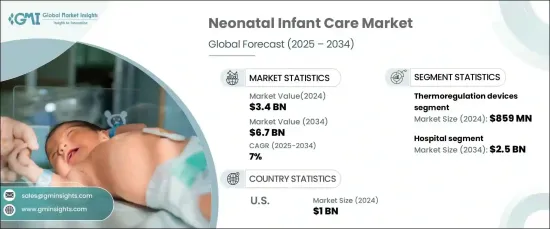
세계의 신생아 및 영유아 치료 시장은 2024년에는 34억 달러로 평가되었으며, 2025년부터 2034년까지의 CAGR은 7%로 큰 성장이 예상됩니다.
이러한 성장은 조산율 증가, 신생아 치료 기술의 지속적인 발전, 전반적인 의료비 지출 증가 등 몇 가지 주요 요인에 의해 주도되고 있습니다. 신생아 치료의 지속적인 발전은 미숙아의 생존율을 높이고 이 취약한 인구의 특수한 요구를 해결하기 위해 고안된 혁신에 의해 추진되고 있습니다. 전 세계 의료 환경이 지속적으로 발전함에 따라 신생아 건강에 대한 인식과 접근성을 높이는 데 초점을 맞추고 전문 치료 솔루션의 광범위한 채택을 유도하는 데도 관심이 높아지고 있습니다. 이는 미숙아의 고유한 건강 요구를 지원할 수 있는 필수 신생아 장비에 대한 수요를 촉진하고 있습니다.

시장 확대에 기여하는 주요 요인은 전 세계 분만의 약 10%를 차지하는 조산율이 증가하고 있다는 점입니다. 미숙아는 장기가 덜 발달하는 등의 문제에 직면하는 경우가 많기 때문에 생존을 위해 전문적인 치료가 필요합니다. 체온 조절을 위한 인큐베이터와 호흡기 치료를 위한 인공호흡기 등 첨단 지원 시스템이 필요합니다. 이러한 장비에 대한 수요의 급증은 특히 신생아 집중 치료실(NICU)에서 두드러지게 나타나며, 이러한 기술은 미숙아의 생존과 장기적인 건강에 중요한 역할을 합니다. 이러한 장비는 더 나은 모니터링과 더 정확한 치료 옵션을 제공함으로써 신생아 치료 환경을 혁신적으로 변화시키고 있습니다.
| 시장 범위 | |
|---|---|
| 시작 연도 | 2024년 |
| 예측 연도 | 2025-2034년 |
| 시작 금액 | 34억 달러 |
| 예측 금액 | 67억 달러 |
| CAGR | 7% |
신생아 및 영유아 치료 시장은 최종 용도별로 병원, 소아 및 신생아 클리닉, 요양원으로 세분화됩니다. 이 중 병원이 2024년에 상당한 점유율을 차지하며 시장을 지배하고 있습니다. 이 부문은 첨단 신생아 기술의 광범위한 채택을 반영하여 2034년까지 25억 달러의 매출을 창출할 것으로 예상됩니다. 병원, 특히 신생아집중치료실은 인큐베이터, 체온조절장치, 호흡 지원 시스템과 같은 최첨단 장비를 갖추고 있습니다. 이러한 시설은 건강 합병증이나 미숙아가 있는 신생아에게 필요한 집중 치료를 제공하는 데 필수적이며, 첨단 신생아 치료 기술에 대한 수요를 더욱 촉진하고 있습니다.
미국의 신생아 및 영유아 치료 시장은 2024년에 10억 달러가 되었고, 선진 의료 인프라와 높은 조산율로 인해 전 세계 시장을 선도하고 있습니다. 체온 조절 시스템, 인공호흡기, 인큐베이터를 비롯한 신생아 치료 제품에 대한 수요는 특히 미국 병원에서 강세를 보이고 있습니다. 신생아 치료 결과를 개선하는 데 초점을 맞춘 미국의 공공 및 민간 부문 전략은 이러한 생명을 구하는 기술의 채택을 지원합니다. 신생아 치료 장비의 지속적인 발전을 통해 미국은 전 세계 신생아 치료 시장에서 중추적인 역할을 담당하며 조산아에게 최적의 결과를 보장하고 있습니다.
The Global Neonatal Infant Care Market is valued at USD 3.4 billion in 2024 and is expected to experience significant growth with a CAGR of 7% from 2025 to 2034. This expansion is driven by several key factors, including the rising rates of premature births, continuous advancements in neonatal care technologies, and the overall increase in healthcare spending. The ongoing evolution of neonatal care is being propelled by innovations designed to improve the survival rates of preterm infants, addressing the specialized needs of this vulnerable population. As the global healthcare landscape continues to advance, there is also a growing focus on enhancing the awareness and accessibility of neonatal health, leading to broader adoption of specialized care solutions. This, in turn, is fueling the demand for essential neonatal equipment that can support the unique health needs of premature infants.

A major factor contributing to the market expansion is the increasing prevalence of preterm births, which account for approximately 10% of all global deliveries. Premature infants often face challenges such as underdeveloped organs, which necessitate specialized care to ensure their survival. They require advanced support systems, including incubators for thermoregulation and ventilators for respiratory care. The surge in demand for these devices is particularly evident in neonatal intensive care units (NICUs), where these technologies play a critical role in the survival and long-term health of preterm infants. By offering better monitoring and more precise treatment options, these devices are revolutionizing the landscape of neonatal care.
| Market Scope | |
|---|---|
| Start Year | 2024 |
| Forecast Year | 2025-2034 |
| Start Value | $3.4 Billion |
| Forecast Value | $6.7 Billion |
| CAGR | 7% |
The neonatal infant care market is segmented by end use into hospitals, pediatric and neonatal clinics, and nursing homes. Among these, hospitals dominate the market, accounting for a substantial share in 2024. This segment is expected to generate USD 2.5 billion by 2034, reflecting the widespread adoption of advanced neonatal technologies. Hospitals, particularly NICUs, are equipped with state-of-the-art equipment, such as incubators, thermoregulation devices, and respiratory support systems. These facilities are essential in delivering the intensive care needed to support newborns with health complications or prematurity, further driving the demand for advanced neonatal care technologies.
The U.S. neonatal infant care market, valued at USD 1 billion in 2024, leads the global market due to its advanced healthcare infrastructure and a high incidence of preterm births. The demand for neonatal care products, including thermoregulation systems, ventilators, and incubators, is particularly strong in U.S. hospitals. The country's focus on improving neonatal care outcomes, combined with public and private sector initiatives, supports the adoption of these life-saving technologies. With continuous advancements in neonatal care equipment, the U.S. remains a pivotal player in the global neonatal infant care market, ensuring optimal outcomes for infants born prematurely.